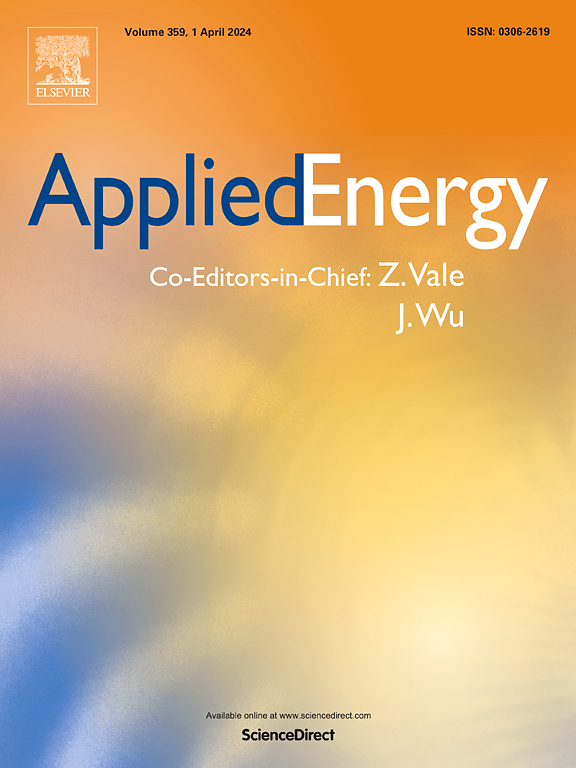通过基于随机森林的可解释人工智能,了解能源储存和可再生能源在脱碳中的协同作用
IF 11
1区 工程技术
Q1 ENERGY & FUELS
引用次数: 0
摘要
可再生能源(RE)和储能系统(ESS)的协调发展对于低碳转型至关重要。除了最佳规划方案外,了解规划结果背后的根本原因对于提高决策透明度和可靠性也至关重要。本研究调查了可再生能源和 MTES 在各个去碳化阶段之间不断发展的协同作用,提出了一个可解释的框架来归因和分析影响规划结果的因素。通过利用随机森林(RF),该框架确定了碳排放限制、资源禀赋和经济约束等不同边界条件下可再生能源与 MTES 协同作用背后的关键驱动因素。通过这种方法,可以详细了解时间和空间因素如何影响规划决策。一项关于中国代表性省份的案例研究说明了可再生能源与储能技术合作的动态演变:长期储能(LDES)支持可再生能源丰富地区的季节性平衡,而短期储能(STES)则缓解热能主导地区的日间波动。基于射频的分析表明,在不同的去碳化阶段,LDES 储能时间(通常超过 100 小时)会对系统的经济性和效率产生显著影响。在碳排放量减少 20% 的情况下,发电结构起着关键作用。然而,当碳排放量减少 40% 以上时,碳成本就会成为决定可再生能源--热电联产规划决策经济可行性的主导因素。通过对规划结果的驱动因素提供可行的见解,本研究提高了可再生能源--多能源和可再生能源战略合作的可解释性,从而支持更加透明和针对特定地区的低碳转型决策。本文章由计算机程序翻译,如有差异,请以英文原文为准。

Understanding the synergy of energy storage and renewables in decarbonization via random forest-based explainable AI
The coordinated development of renewable energy (RE) and energy storage systems (ESS) is crucial for low-carbon transitions. Beyond optimal planning solutions, understanding the underlying reasons behind planning outcomes is essential to enhance decision-making transparency and reliability. This study investigates the evolving synergy between RE and MTES across decarbonization stages, proposing an explainable framework to attribute and analyze the factors influencing planning outcomes. By leveraging Random Forest (RF), the framework identifies key drivers behind RE-MTES synergies under diverse boundary conditions, such as carbon emission limits, resource endowments, and economic constraints. This approach provides a detailed understanding of how temporal and spatial factors shape planning decisions. A case study on representative Chinese provinces illustrates the dynamic evolution of RE-MTES collaboration: long-duration energy storage (LDES) supports seasonal balancing in RE-rich regions, while short-term energy storage (STES) mitigates intraday fluctuations in thermal-dominated areas. The RF-based analysis reveals that, at various decarbonization stages, LDES storage time, typically exceeding 100 h, significantly impacts system economics and efficiency. With a 20 % reduction in carbon emissions, the power generation structure plays a key role. However, beyond a 40 % reduction, carbon costs become the dominant factor in determining the economic viability of RE-MTES planning decisions. By offering actionable insights into the drivers of planning outcomes, this study advances the explainability of collaborative RE-MTES strategies, sup-porting more transparent and region-specific decision-making for low-carbon transitions.
求助全文
通过发布文献求助,成功后即可免费获取论文全文。
去求助
来源期刊

Applied Energy
工程技术-工程:化工
CiteScore
21.20
自引率
10.70%
发文量
1830
审稿时长
41 days
期刊介绍:
Applied Energy serves as a platform for sharing innovations, research, development, and demonstrations in energy conversion, conservation, and sustainable energy systems. The journal covers topics such as optimal energy resource use, environmental pollutant mitigation, and energy process analysis. It welcomes original papers, review articles, technical notes, and letters to the editor. Authors are encouraged to submit manuscripts that bridge the gap between research, development, and implementation. The journal addresses a wide spectrum of topics, including fossil and renewable energy technologies, energy economics, and environmental impacts. Applied Energy also explores modeling and forecasting, conservation strategies, and the social and economic implications of energy policies, including climate change mitigation. It is complemented by the open-access journal Advances in Applied Energy.
 求助内容:
求助内容: 应助结果提醒方式:
应助结果提醒方式:


